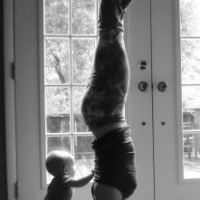Kegels are vagina-centric, 60 years old and named after a guy. We can do better than that. -Leslie Howard
The 8th annual Yoga Journal Conference in San Francisco features thirty women, three plastic pelvises and Leslie Howard, all talking shop (well, all but the plastic pelvises, they mostly just watched) about nuances of the female pelvic floor.
Leslie began by inviting students to share their own perspectives about why they were drawn to an intensive on the female pelvis. In a room sans men, all of the women were remarkably candid, talking about various kinds of problems, from urinary incontinence to organ prolapse to sexual dysfunction and more. Some knew they had a problem, but didn’t know the what it was exactly or how to fix it.
Others were Pilates teachers or yoga teachers looking to continue their education. But in order to find out where to go, we must find out where to start.
So Leslie dives in: “Let’s start with Kegels…what are they? Doctor’s tell you to do them all the time, right? So can anyone tell me what they are?”
Listening to the answers of the women, it becomes clear that the answers are themselves muddled, with much of our understanding of the female pelvic floor being cultural and not nearly factual or at times even useful. The common understanding of a kegel is to contract the muscle that will “stop the urine flow.” But Leslie quickly indicates that although well-meaning, this isn’t accurate.
Over the course of the nine hours that Leslie taught, we learned not only about the anatomy of the female pelvic floor, but about the cultural understanding and history of the female pelvis and how our current lifestyle leads to dysfunction.
Think about it: It wasn’t a even hundred years ago that women (or men for that matter) spent their days squatting, cooking and farming, instead of sitting in a chair in front of a computer screen all day. Such bad posture, combined with exercise programs that focus on the traditional six pack abs put strain on the internal organs, on the spine and especially on the pelvic floor.
If you want to notice the changes, just compare a small child to an adult, as Leslie points out:
If you look at babies and small children, you will notice that the lumb0-sacral angle
is pronounced and that the lumbar is relatively flat. Somewhere along the way we are taught to hold
it in, pulling the pelvis into “tuck” or retroversion.
Leslie doesn’t exempt herself from these issues, but in fact teaches from a place of self exploration, outlining how she came to study the pelvic floor and even how her overzealous practice led to increased problems and therefore increased understanding of how the muscles work. She now recommends a balanced approach to female pelvic health that combines understanding of the female anatomy, self exploration and subtle inquiry of certain body movements.
But she is careful to point out that this work is subtle and individualized for each student. It’s all connected after all, from sexual history, to trauma, birth, stress and posture. But the inviting aspect of this work is that it is available to all students, of all ages and regardless of yoga ability, or lack thereof.
It took every minute of nine hours to explain, exactly, how the female pelvic floor works, what it is, why we should care and what to do about it. But there wasn’t a yawn or a bored look in the house, because she took care to approach the information that could be sensitive for some, in a welcoming and often funny way.
I’ll leave you with this quote, from Leslie, on the prevalence of over-tucking the pelvis in current western lifestyle:
Take me, for example,
I’m a chronic tucker. You could call me one Mother Tucker.
For more information on Leslie Howard, please visit www.lesliehowardyoga.com











Read 1 comment and reply